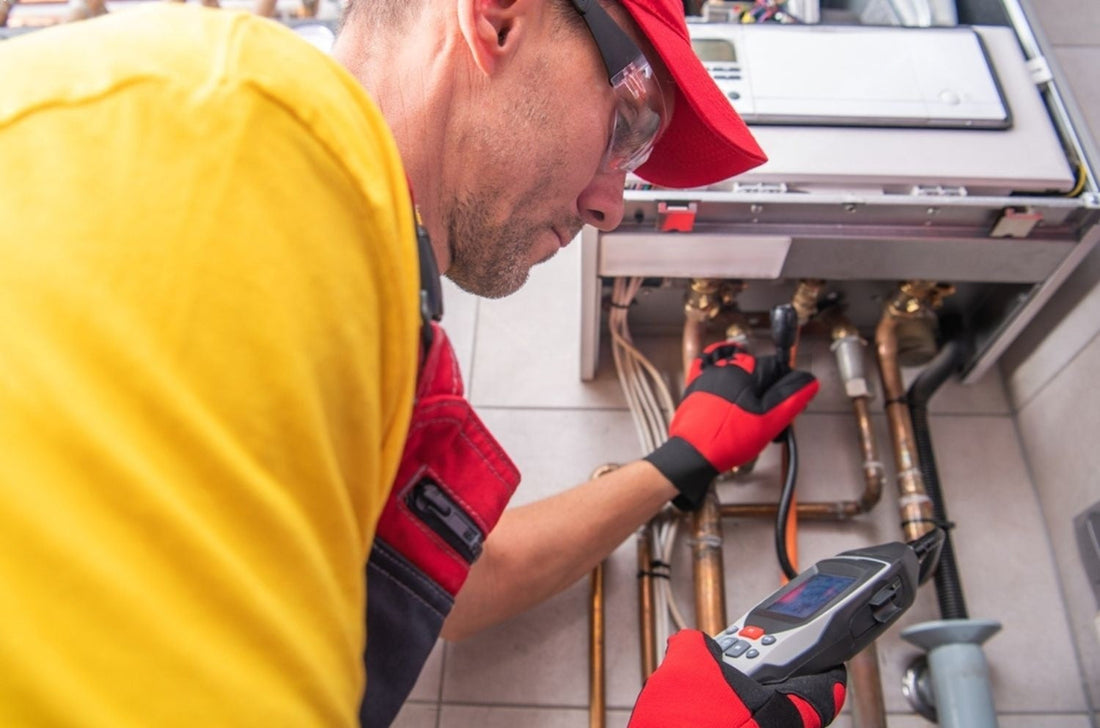
The Role of 360° Imaging in Professional Drain Surveys
Share
Commercial drain surveys stand for a high-tech, non-invasive inspection of various commercial properties’ sewage and underground drainage systems, using CCTV cameras to detect structural damage, leaks, or other issues like vermin or tree root intrusion. 360° imaging, in this regard, captures HD footage of damages within a minimum time, and since it does not require any manual planning, it dramatically improves inspection accuracy and efficiency.
But how does it work, and why is it important for plumbers? Let’s find out.
What is 360° Imaging in Drain Surveys?
360° drain cameras play a key role in drain inspection systems, as they are solely designed to produce a panoramic view of pipelines to identify defects or any other issues. Unlike traditional cameras, these cameras use multiple wide-angle lenses or a rotating lens to generate seamless images, while the gyroscopic stabilization and LED lighting allow professionals to map the internal structure.
However, in contrast to traditional drain cameras, which provide limited-angle and linear footage, 360° cameras record a full-circumference view of pipes. It is a more accurate, time-efficient, and reliable method of inspection before starting any damage-repairing project.
The panoramic images provide a virtual view of pipe interiors, which helps to understand the defects more efficiently. It also ensures details regarding joint displacement, crack detection, blockages and leads to informed, data-driven decisions, considering high-definition videos.
How 360° Imaging Works in Practice
Here you can find different steps and stages followed in commercial drain surveys, using 360° imaging, as well as other software-based practices.
Step 1: Planning and Preparation
- At the initial stage, the survey provider or drainage engineer discusses several aspects of drainage concerns and the required strategies to fix the issue.
- The skilled technicians assess the entire drainage system to identify several entry points, such as manholes and cleanouts, for setting up inspection equipment.
- The 360° camera is mostly attached to a flexible rod or a crawler unit (remote-controlled), based on the diameter of pipes.
Step 2: Live Inspection and 360° Imaging
- The 360° cameras are waterproof in nature, and they’re inserted into drains through access points, while the LED lights illuminate the interior of pipes.
- In cases of regular or emergency drain surveys, through the pipes, the camera is maneuvered with a push rod or remotely.
- The unique optical system of 360° imaging cameras captures seamless and HD views of the pipe interior, and the live video feed can easily be monitored on screen, ensuring a real-time analysis report.
Step 3: Real-time Reporting and Software Integration
- The integrated software system records relevant data, and technicians can have an HD snapshot before integrating with several mapping tools like Google Maps or developing architectural plans.
- The software classifies and codes defects as per industrial standards, such as MSCC5. A digital interface is used to observe issues like root intrusion and collapses.
- It fosters an automatic inspection system, generating a comprehensive report, while several platforms use AI to streamline the process and summarize the findings.
- Real-time data sharing and instant reports via cloud link or email have been useful, as well as the customized practices.
Step 4: Post-Survey Review and Action Plan
- The clients mostly receive interactive reports, including video clips as well, which allow them to see the current condition of the drain.
- The final reports also provide recommendations, based on the emergency drain surveys, regarding repair work or further investigation.
- The upgraded inspection systems repair estimates, generate work orders or follow-up tasks, empowering the remediation processes.
Key Advantages of 360° Imaging for Drain Surveys
As a plumber, you can resort to 360° imaging for the following reasons:
- 360° cameras provide a spherical and complete view of the interior section of drains, ensuring every detail regarding corrosion, hairline cracks or any other damage.
- The use of advanced systems, especially in cases of pipe inspection systems, is beneficial for developing interactive 3D models of infrastructures, which can be annotated, measured, and exported for CAD (computer-aided design) programs, empowering precise rehabilitation planning.
- 360° technology empowers faster inspections, which do not require any manual plans for studying the defects. It reduces on-site time, since an inspection can be conducted easily by moving cameras through pipes.
- The inspection process can be separated effectively from the evaluation process, as the drain cameras capture full views and technicians can review the data remotely.
- The technology fosters precise measurements, providing accurate information and data regarding misaligned joints, pipe diameter, and several structural issues.
- The data derived from the pipe inspection system, including 3D models, can effectively be integrated with geographical information system (GIS) maps, which further provide a comprehensive visual tool for rehabilitation planning and professional maintenance.
- The automatic inspection system, driven by 360° imaging technologies, allows cost-effective and targeted solutions, while the early detection of several minor issues prevents the drainage system from any extended damage or expensive damage-repairing plan.
|
Aspect |
360° Imaging |
Traditional Methods |
|
Coverage |
Complete panoramic view in one capture |
Limited angle, multiple shots needed |
|
Accuracy |
High detail with spatial context |
Often fragmented, risk of misinterpretation |
|
Efficiency |
Faster documentation, fewer retakes |
Time-consuming, manual adjustments |
|
Accessibility |
Easy digital sharing, remote viewing |
Requires physical presence or reports |
|
Cost-Effectiveness |
Higher upfront, long-term savings |
Lower initial, higher labor costs |
|
Applications |
Real estate, inspections, training |
Photography, basic documentation |
Table: Comparing 360° Imaging with Traditional Methods
Why 360° Imaging Matters in Modern Infrastructure Management
Plumbers nowadays are striving towards making every job simpler, and 360° imaging helps them with that.
- Since 360° Imaging generates high-resolution imagery of damages or defects from the interior section of pipes, it has been beneficial mostly in urban areas. Due to the increasing population and industrial programs, the drainage system in Urban areas is deeply affected. Using 360° technologies, the issues can be easily identified before it's too late for the infrastructure.
- As real-time services have been key driving factors for professionals, this technology is widely used due to its ability to reduce the need for time-consuming, expensive, and, in cases, risky on-site inspections, which further reduces operational costs.
-
The sustainability factors empowered by 360° Imaging technologies have made it more popular in the modern infrastructure management system. It prevents additional excavation, as well as allows remote assessment of damages, which lowers the environmental footprint of on-site teams and logistical burden.
Summary
As 360° imaging provides a comprehensive panoramic image of pipelines, it is essential for professional drain examinations since it allows for the precise detection of obstructions, cracks, root infiltration, and structural flaws. In contrast to conventional CCTV techniques, it offers HD video, real-time reporting, and interaction with cutting-edge software for accurate GIS mapping and defect coding. In both commercial and urban drainage systems, 360° imaging improves efficiency, sustainability, and long-term infrastructure management through rapid, non-invasive inspections, less on-site time, and more affordable results.
Still unsure about the utility and benefits of 360° Imaging? Visit our website to find the best services and experience the difference.
Frequently Asked Questions
1. In Comparison to Conventional CCTV Assessments, How Can 360° Imagery Increase the Classification Accuracy of Drain Defects?
Engineers can rotate and zoom into particular areas of the drain's inside through 360° cameras, which offer a panoramic, distortion-free image. Compared to traditional CCTV, which depends on a fixed forward-facing angle, this results in much more accurate joint displacement analysis, the assessment of fracture diameter, and root entry identification.
2. Is It Possible to Include 360° Imaging Data Into Drainage Network Predictive Maintenance Systems?
Indeed. AI-based prediction tools and asset management software can be combined with the digital records from 360° imaging. Instead of waiting for system breakdowns, this allows engineers to plan proactive maintenance, prioritize repairs, and predict deterioration patterns.
3. How Can 360° Imagery Contribute to Drainage Inspection Requirements Compliance?
By obtaining high-resolution, full-pipe images, 360° imaging ensures that survey results comply with industry codes. By removing uncertainty from coding errors, these illustrations assist plumbing professionals in regularly meeting regulatory reporting requirements.
4. In Contrast to Home Inspections, How Does 360° Imaging Help Large-scale Commercial or Municipal Drainage Projects?
360° imagery significantly reduces survey time for big networks while offering cloud access and scalable data storage. This is especially helpful for municipal projects where hundreds of meters of pipeline need to be tracked and evaluated in real time by numerous parties.
